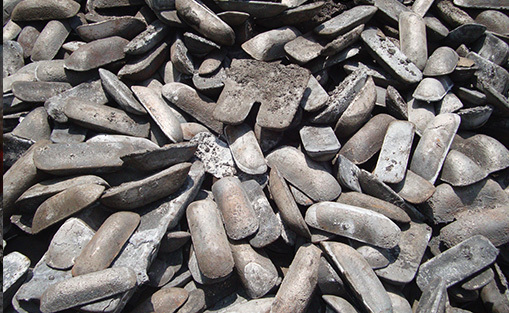Iron Ore
Iron ore mining began in the Lal Lal district in 1857. The Lal Lal Iron Mining Company was formed in 1874 after the liquidation of the Victoria Iron Company. The plant including the Lal Lal Blast Furnace was opened in 1878 but a new and larger blast furnace was built two years later. The mine reached its peak in 1884 when 1,600 tons of ore was smelted and 800 tons of pig iron produced. Within a few years production rapidly declined.
The company set up an iron ore quarry and smelting works, which at its peak employed 160 men. Charcoal from local timber, brown coal from the area and Ballarat coke were all used as fuel for the smelting process.
The first furnace installed was very crude and consisted of a boiler shell lined with fire brick. The fuel used was charcoal and the limestone flux was obtained from Geelong. Later an improved type was built, using coke as fuel, and the output rose to 5 tons per day.
The ironworks closed in 1885 after producing 2,607 tons of iron from 5,230 tons of ore. The value for the output over ten years was in the vicinity of 12,000 pounds

The first casting at the Lal Lal Iron Works, 1878. State Library of Victoria
Pig Iron
Pig iron is the name given to the metallic product of a furnace containing more than 90 percent iron. It became known as pig iron because of the way the iron moulds stretched out either side of a runner into which blast furnace iron was poured. The runner was known as the sow and the moulds branching out from the sow were called pigs.
Pig iron results from the smelting of iron with a high carbon fuels such as, coke, anthracite or charcoal. Limestone is used as a flux. Anthracite is the coal with the highest coal content and lesser amount of impurities. Because of pig iron's high content of carbon, silica and any other mass of impurity that floats on the molten metal, called dross, it can be quite brittle and therefore has limited applications. For these reasons it is an intermediate product that requires further melting to enable it to be used in the producing of steel.

Raw pig iron is used in the manufacturing of wrought iron in puddling furnaces and in recent times turned into steel. This is achieved by melting the pig iron while blowing a strong current of air over the melted metal as it is being agitated or stirred. This action causes any silicon and other dissolved impurities to become oxidised.
Pig iron can also be turned into a product known as grey iron. This is achieved by remelting the pig iron along with scrap iron and steel, after removing the impurities alloys are added and the carbon content adjusted. Some grades of pig iron are found suitable for the production of ductile iron, commonly known as cast iron.
Be sure to check out the Blast Furnace listed in the additional waypoints section
Questions
1. At the posted coordinates you will find yourself standing in Iron Mine number 3, what is the predominant colour and why do you think this is?
From information given…
2. What are the impurities that float on the molten metal called?
3. Briefly describe how is Grey Iron produced?
Email your answers through my geocaching.com profile.
Please feel free to log at your leisure, but logs without corresponding email for will be deleted.
Further reading
Mining Link https://is.gd/mQhEnM
Federation Uni https://is.gd/ckAuPG